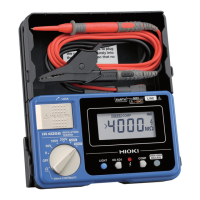4.1 Troubleshooting
Unable to perform
measurement in
500 V or 1,000 V
range.
The 500 V and 1,000 V ranges use double-action
to prevent the inadvertent application of the
measurement signal.
Press after setting the rotary selector to
the 500 V or 1,000 V range. Pressing
while holding the MEASURE key will not
disable the lock function.
The measured
value is shown as
the maximum
display value.
There is a broken connection in a test lead.
Check the continuity of the test lead with a
tester.
The test leads are not securely connected.
Check the connection between the test leads
and the instrument, and check the connection
of the tips of the test leads.
The batteries run
out immediately.
You are using nickel-metal-hydride battery or
manganese batteries.
Replace the batteries with alkaline batteries.
The instrument
won’t turn on.
The batteries are dead.
Replace the batteries.
The batteries have been installed improperly.
Install the batteries in the proper orientation.
The insulation
resistance
measured value
increases over
time.
This phenomenon reflects the influence of the
measurement target’s capacitance component.
This is not a malfunction or error.
If the measured value fluctuates gradually, wait
for it to stabilize and then use that value.
There is excessive
variation in the
measured value.
The variation is caused by induced noise from a
charging circuit located near the measurement
target.
Disconnect the circuit breaker for any nearby
charging circuits. If this is not possible, use the
lowest measured value as the measurement
result.
The measurement target has a large capacitance
component (capacitor).
If it is possible to remove the capacitor, do so.
If not, use the lowest measured value as the
measurement result.
Symptom Check Items

